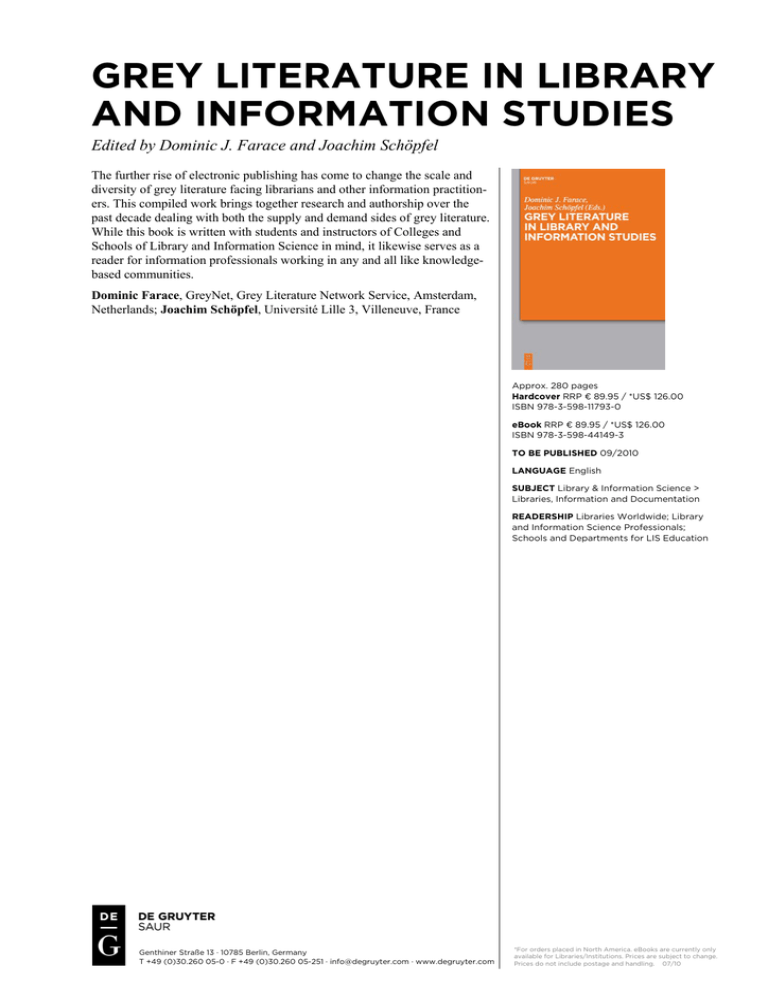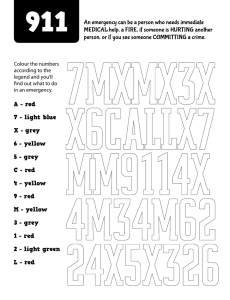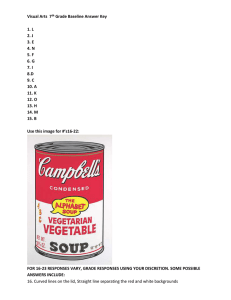grey literature in library and information studies
advertisement

GREY LITERATURE IN LIBRARY AND INFORMATION STUDIES Edited by Dominic J. Farace and Joachim Schöpfel x The further rise of electronic publishing has come to change the scale and diversity of grey literature facing librarians and other information practitioners. This compiled work brings together research and authorship over the past decade dealing with both the supply and demand sides of grey literature. While this book is written with students and instructors of Colleges and Schools of Library and Information Science in mind, it likewise serves as a reader for information professionals working in any and all like knowledgebased communities. Dominic Farace, GreyNet, Grey Literature Network Service, Amsterdam, Netherlands; Joachim Schöpfel, Université Lille 3, Villeneuve, France Approx. 280 pages Hardcover RRP € 89.95 / *US$ 126.00 ISBN 978-3-598-11793-0 eBook RRP € 89.95 / *US$ 126.00 ISBN 978-3-598-44149-3 TO BE PUBLISHED 09/2010 LANGUAGE English SUBJECT Library & Information Science > Libraries, Information and Documentation READERSHIP Libraries Worldwide; Library and Information Science Professionals; Schools and Departments for LIS Education Genthiner Straße 13 · 10785 Berlin, Germany T +49 (0)30.260 05-0 · F +49 (0)30.260 05-251 · info@degruyter.com · www.degruyter.com *For orders placed in North America. eBooks are currently only available for Libraries/Institutions. Prices are subject to change. Prices do not include postage and handling. 07/10 Contents Introduction Grey Literature (Farace and Schöpfel) Part I – Producing, Processing, and Distributing Grey Literature Section One: Producing and Publishing Grey Literature Chapter 1 Grey Publishing and the Information Market: A New Look at Value Chains and Business Models (Roosendaal) Chapter 2 How to assure the Quality of Grey Literature: The Case of Evaluation Reports (Weber) Chapter 3 Grey Literature produced and published by Universities: A Case for ETDs (Južnič) Section Two: Collecting and Processing Grey Literature Chapter 4 Collection building with special Regards to Report Literature (Newbold and Grimshaw) Chapter 5 Institutional Grey Literature in the University Environment (Siegel) Chapter 6 Copyright Concerns Confronting Grey Literature (Lipinski) Section Three: Channels for Access and Distribution of Grey Literature Chapter 7 Theses and Dissertations (Stock and Paillassard) Chapter 8 Grey Documents in Open Archives (Luzi) Chapter 9 OpenSIGLE – Crossroads for Libraries, Research and Educational Institutions in the Field of Grey Literature (Farace, Frantzen, Stock, Henrot, and Schöpfel) Part II – Uses, Applications, and Trends in Grey Literature Section Four: Applications and Uses of Grey Literature Chapter 10 The driving and evolving Role of Grey Literature in High-Energy Physics (Gentil-Beccot) Chapter 11 The Use and Influence of Information Produced as Grey Literature by International, Intergovernmental Marine Organizations: Overview of Current Research (MacDonald, Wells, Cordes, Hutton, Cossarini, and Soomai) Chapter 12 Grey Literature in Karst Research: The Evolution of the Karst Information Portal, KIP (Chavez) Chapter 13 Grey Literature Repositories: Tools for NGOs Involved in Public Health Activities in Developing Countries (Crowe, Hodge, and Redmon) Section Five: Future Trends in Grey Literature Chapter 14 Blog Posts and Tweets: The Next Frontier for Grey Literature (Banks) Chapter 15 Assessing the Return on Investments in Grey Literature for Institutional Repositories (Schöpfel and Boukacem) Chapter 16 e-Science, Cyberinfrastructure and CRIS (Jeffery and Asserson) Chapter 17 Course and Learning Objective in the Teaching of Grey Literature: The Role of Library and Information Science Education (Rabina) Appendices Appendix I Biographical Notes on the Authors Appendix II Index to Web based Resources in Grey Literature Appendix III List of Grey Literature Document Types Appendix IV Collections of Conference based Papers, 1993–2010 Appendix V Thematic Index – The Grey Journal, 2005–2010 Keyword Index




